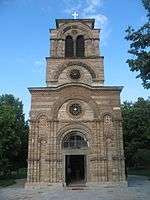Vlah Church
| Vlah Church Влашка Црква | |
|---|---|
 | |
| Basic information | |
| Affiliation | Serbian Orthodox Church |
| Municipality | Cetinje |
| State | Serbian Despotate (modern-day Montenegro) |
| Province | Zeta |
| Ecclesiastical or organizational status | Metropolitanate of Montenegro and the Littoral |
| Architectural description | |
| Founder | Vlachs who guarded the cattle of Ivan Crnojević |
| Completed | c. 1450 |
| Specifications | |
| Direction of façade | West |
| Materials |
|
The Vlah Church (Serbian: Влашка Црква) is a Serbian Orthodox church built in 1450 in the village, Donji Kraj[1] (on Cetinje field), Zeta, Serbian Despotate (modern day Montenegro).
Stećci
The church was built around 1450 on the site of Bogumils' necropolis, which had around 150 stećci (monumental, ornate tombstones).[2] Only two of them are preserved today. Originally they faced each other, and were recently reoriented to be side by side.[3] According to some legends, recorded for the first time by Ljubomir Nenadović,[4] the 17th-century military commander Bajo Pivljanin and his wife are buried beneath them.[5] According to another legend and documentary evidence the stećci mark the graves of the founders of the church -- Ivan Borojević, born in Stari Vlah, and his wife Jelica.[6]
Origin of the name
This church received its name for the Vlahs[A] who guarded the cattle of Ivan Crnojević and built the church around 1450.[7][8]
There are several additional theories about the origin of the term Vlah in the name of the church. Some authors believe that the term Vlahs in the name of this church is used as an exonym.[2] Other theories connect the name of the church to Eastern Orthodox Christianity and population which were referred to as Vlahs[9] or to demonym Vlahs (according to them this church was allegedly built by settlers from Stari Vlah).[10]
Building materials
The church was initially made of "plot" (Serbian: плот), i.e. of sticks, switches and mud. It was rebuilt three times. First as "suvomeđa" (Serbian: сувомеђа), which means of stones without mortar; then of "klačena" (Serbian: клачена), which is stones with lime mortar; and finally, in 1864 the church received its current form.[11][12] A guard rail around the church was built in 1897 using barrels of Ottoman rifles[13] captured in 1858 during the Battle of Grahovac.[14]
Notes
References
- ↑ Simo Popović; Jovan R. Bojović; Novica Rakočević (1995). Memoari. CID. p. 41. Retrieved 26 April 2013.
"Влашка црква" коју је сада захватила варош била је прије рата још далеко од Цетиња на голој пољани. Она управо и не припада Цетињу него Доњем крају још од старога времена, када није ни било Цетиња.
- 1 2 Ratko Đurović (1969). Crnom Gorom. "Binoza," Grafički zavod Hrvatske. p. 97. Retrieved 26 April 2013.
- ↑ Batričević, Đuro; Cvetko Pavlović (10 September 2004). "Legende o Vlaškoj crkvi". Pobjeda. Retrieved 27 April 2013.
Prema Erdeljanovićevoj zabiljeci, dva sačuvana nadgrobna kamena bila su najprije okrenuta uzglavljem jedan prema drugom, pa su „u najnovije vrijeme” stavljeni naporedo.
- ↑ Batričević, Đuro; Cvetko Pavlović (10 September 2004). "Legende o Vlaškoj crkvi". Pobjeda. Retrieved 27 April 2013.
Ljubomir Nenadović bio je prvi koji je zapisao da su pomenuti nadgrobni kamenovi pripadali istaknutom hajdučkom harambaši Baju Nikoliću Pivljaninu i njegovoj supruzi.
- ↑ Draško Šćekić (1987). Putujući Crnom Gorom. NIO "UR". p. 102. Retrieved 26 April 2013.
- ↑ Batričević, Đuro; Cvetko Pavlović (10 September 2004). "Legende o Vlaškoj crkvi". Pobjeda. Retrieved 27 April 2013.
Naime, prema legendi, sačuvani nadgrobni spomenici pripadali su Ivanu Borojeviću i njegovoj ženi Jelici.
- ↑ Narodno stvaralaštvo: Folklor. Nauchno delo. 1962. p. 17. Retrieved 26 April 2013.
Познато је да су чобани Ивана Црнојевића по Цетињском пољу и кроз Ловћен чували стоку. Они су са- градили цркву.
- ↑ Istorijski zapisi: organ Istoriskog instituta i Društva istoričara SR Crne Gore. Istorijski institut u Titogradu. 1948. p. 246. Retrieved 26 April 2013.
Влашка црква је подигнута од пастира Ивана Црнојевића
- ↑ Zlatko Kudelić (2007). Marčanska biskupija: Habsburgovci, pravoslavlje i crkvena unija u Hrvatsko-slavonskoj vojnoj krajini (1611. - 1755). Hrvatski Inst. za Povijest. p. 131. ISBN 978-953-6324-62-0. Retrieved 26 April 2013.
pojmovi "vlaška crkva" ili "vlaški ili grčki obred" označavali su pripadnost Pravoslavnoj crkvi i pravoslavlju.
- ↑ Јован Ердељановић (1926). Стара Црна Гора: етничка прошлост и формирање црногорских племена. Слово љубве. p. 299. Retrieved 26 April 2013.
...што су они били по- реклом из Старог Влаха, ова њихова црквица добије назив Влашка Црква .... Да су ту цркву заиста градили ови досељеници из Старога Влаха
- ↑ Batričević, Đuro; Cvetko Pavlović (10 September 2004). "Legende o Vlaškoj crkvi". Pobjeda. Retrieved 27 April 2013.
Ona je prvobitno bila opletena prućem i oblijepljena blatom, a bila je sagrađena od „plota” i „kočeva”. Vlaška crkva je tri puta prepravljana: prvo kao suvomeđa, zatim od „klačnog zida”, da bi najzad, 1864. godine, dobila svoj današnji izgled.
- ↑ Ilustrovani zvanični almanah-šematizam Zetske banovine. Državna štamparija. 1931. p. 251. Retrieved 27 April 2013.
Влашка Црква, сазидана како данас изгледа 1864 на темепьима старе цркве из 1450
- ↑ Michael Spring (20 February 1987). Great Europ Itinerar. Doubleday. p. 224. ISBN 978-0-385-23336-1. Retrieved 26 April 2013.
The railings around the fifteenth-century Vlah Church (Vlaska crkva) were made in 1897 from barrels of 1,550 captured Turkish rifles.
- ↑ Glasnik Srpskog istorijsko-kulturnog društva "Njegoš". Njegoš. 1979. p. 125. Retrieved 26 April 2013.
Одмах је ту и Влашка црква, са чувеном оградом од пушчаних цијеви, пушака заробљених у граховској бици
- ↑ Narodno stvaralaštvo: Folklor. Nauchno delo. 1962. p. 17. Retrieved 26 April 2013.
Coordinates: 42°23′27″N 18°55′28″E / 42.3909°N 18.9244°E
